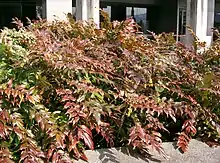| Berberis japonica | |
|---|---|
 | |
| Scientific classification | |
| Kingdom: | Plantae |
| Clade: | Tracheophytes |
| Clade: | Angiosperms |
| Clade: | Eudicots |
| Order: | Ranunculales |
| Family: | Berberidaceae |
| Genus: | Berberis |
| Species: | B. japonica |
| Binomial name | |
| Berberis japonica | |
| Synonyms[1] | |
| |
Berberis japonica is a species of flowering plant in the family Berberidaceae, native to Taiwan.[2] Despite the name, it is not native to Japan, though it has been known in cultivation there for centuries. The wild origins of this species have long puzzled botanists, but wild plants in Taiwan, previously known under the name Mahonia tikushiensis, appear most similar to the cultivated forms of B. japonica.[3]
Description
It is an evergreen shrub growing to 2 m (7 ft) tall by 3 m (10 ft) wide.[4] The foliage is pinnate, glossy dark green above, paler beneath, and sharply toothed. Each leaf usually has six to eight pairs of leaflets together with a single terminal leaflet. The plant produces new shoots regularly from the base, so it is clothed in foliage at all levels.
The small, scented, yellow flowers are borne from autumn through winter into spring. The inflorescences are 25 cm or more long, at first arching and then pendant. Blue or black fruits develop in spring and summer.[2][5][6][7][8]
Taxonomy
Berberis japonica was initially scientifically described and named by Carl Peter Thunberg as Ilex japonica in 1784, believing it to be a true holly.[1] In 1821 Augustin Pyramus de Candolle reclassified it as Mahonia japonica. Disagreeing with this, Kurt Polycarp Joachim Sprengel clasified it in Berberis as Berberis japonica in 1825.[1] A paper was published by Joseph Edward Laferrière in 1997 summarized the arguments for Mahonia being more properly classified as a synonym of Berberis.[9] As of 2023 this is the most common classification by botanists.[1]
Cultivation
The plant is much grown as an ornamental shrub, and for use in landscapes. It is of value for its bold foliage, flowers in flowering season, and as a groundcover landscape shrub. Its spiny foliage invite use in security hedging.
Berberis japonica has received the Royal Horticultural Society's Award of Garden Merit.[10][11] The hybrid between it and Berberis oiwakensis subsp. lomariifolia is also a popular garden plant. Known as Berberis × hortensis, several cultivars have been developed from it, including 'Charity', 'Winter Sun' and 'Lionel Fortescue'.[12] A hybrid with Berberis napaulensis var. napaulensis (M. siamensis), called Mahonia × lindsayae 'Cantab', though less well known, is a useful garden plant[13] and also holds an Award of Garden Merit.[4]
Berberis bealei, native to mainland China[14] and also widely cultivated, is usually treated as a separate species, but in the past has been listed as a cultivar of Berberis japonica.[3] Its most obvious differences from B. japonica are in shorter, upright flowering racemes and wider leaflets.
References
- 1 2 3 4 "Berberis japonica (Thunb.) Spreng". Plants of the World Online. Royal Botanic Gardens, Kew. Retrieved 12 November 2023.
- 1 2 Flora of China v 19 p 781, Mahonia japonica
- 1 2 Bayton, Ross (2017). "The identity of Mahonia japonica". The Plantsman. New Series. 16 (4): 244–248.
- 1 2 RHS A-Z encyclopedia of garden plants. United Kingdom: Dorling Kindersley. 2008. p. 1136. ISBN 978-1405332965.
- ↑ Thunberg, Carl Peter. 1784. Flora Japonica 77, Ilex japonica
- ↑ Brown, Robert. 1818. Observations systematical and geographical on the herbarium collected by Professor Christian Smith, in the vicinity of the Congo: during the expedition to explore that river, under the command of Captain Tuckey in the year 1816. London, App. 22, Berberis japonica
- ↑ Candolle, Augustin Pyramus de. 1821. Regni Vegetabilis Systema Naturale 2: 22.
- ↑ Hayata, Bunzô. 1915. Icones plantarum formosanarum nec non et contributiones ad floram formosanam 5: 5–6, Mahonia tikushiensis
- ↑ Laferrière, Joseph Edward (1997). "Transfer of Specific and Infraspecific Taxa from Mahonia to Berberis (Berberidaceae)". Botanicheskii Zhurnal. 82 (9): 95–97. Retrieved 8 November 2023.
- ↑ "RHS Plantfinder - Mahonia japonica". Retrieved 25 March 2018.
- ↑ "AGM Plants - Ornamental" (PDF). Royal Horticultural Society. July 2017. p. 62. Retrieved 25 March 2018.
- ↑ Brickell, C.D. (1979). "The hybrids between Berberis japonica and M. lomariifolia". The Plantsman. 1: 12–20.
- ↑ Cullen, J. (2012). "Mahonia × lindsayae 'Cantab'". Curtis's Botanical Magazine. 29 (2): 122–136. doi:10.1111/j.1467-8748.2012.01778.x.
- ↑ Flora of China v 19 p 778, Mahonia bealei